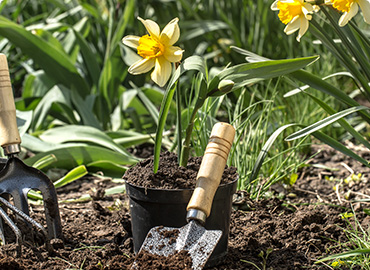Although it may appear counterintuitive, separating a tiny space into smaller parts based on function actually lets a small yard breathe. When divided into smaller micro zones, a long and narrow yard can have a water garden, al fresco dining area, play space, hardworking storage shed, and plenty of flowers for filling vases. Use varying heights to separate different portions of your outdoor space. You can keep it simple with a raised bed or a raised wooden deck, or go all out with an artistically terraced endeavor that separates the kids’ play area from the rest of the outdoor living space. Maintain a comparable material underfoot as you divide your garden into functional regions to weave a connecting thread between the spaces.
A simple visual indication, such as gravel or scarlet rocks, indicates that locations, such as a container garden forest, a reflecting pool, and a perennial wildflower border, are linked by more than simply geographical closeness.
Avoid utilizing hardscape materials that are too large for the space in a tiny garden. They have the potential to overwhelm a tiny yard
Bringing the sky into the yard is a sure-fire method to make a modest garden appear as huge as the great outdoors. A mirrored surface created by a water garden with a black liner reflects the sky and light into this small space. Trim trees in your garden so that their branches don’t hide the sky. Maintaining an upward perspective creates a roomy ambiance in small spaces.
 Structures, furnishings, and even individual plants are all subject to the same rule. Choose trees with neat dimensions that suit the garden.
Structures, furnishings, and even individual plants are all subject to the same rule. Choose trees with neat dimensions that suit the garden.
rather than overwhelming it. Many dwarf-growing plants and trees have the same impact as larger varieties.
If you have a small garden, get imaginative with containers and skip the earth-bound beds. Invest in simple planting boxes and wall planters or a wooden wall trellis. We have a choice of wall planters with coco liners to fit any size wall or fence!
When you add the sound of trickling water to a tiny environment, it appears to expand. Choose a small tabletop fountain, a wall fountain with a modest footprint, or a DIY water feature that you construct yourself. Trickling water creates an instant sense of calm, attracts songbirds, and helps to mask distracting noises in a tiny garden. Consider the influence on drainage before making any height modifications, adding raised beds, or removing lawn in a tiny garden. It’s a good idea to contact us if you’re adding hard surfaces and terraces to make sure you’re not causing drainage problems. Small gardens are renowned for requiring meticulous draining.


Leave a Reply